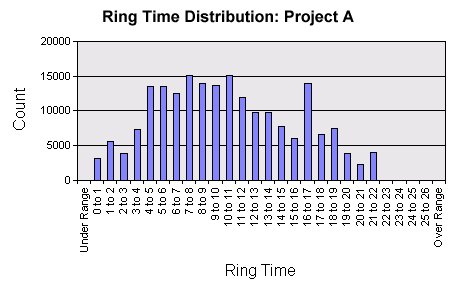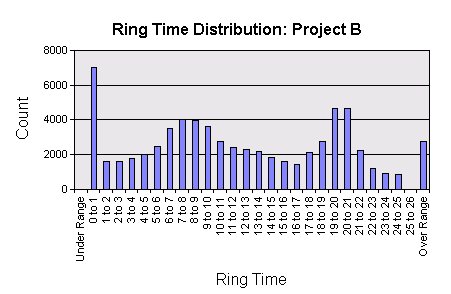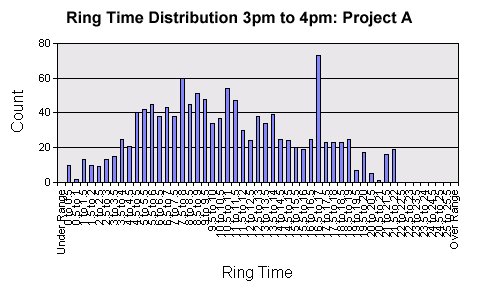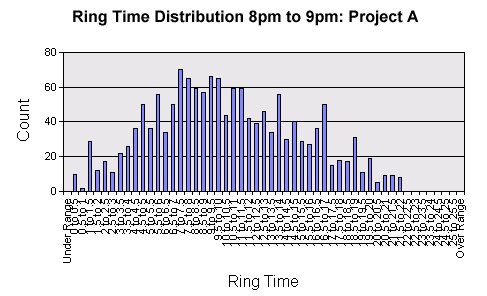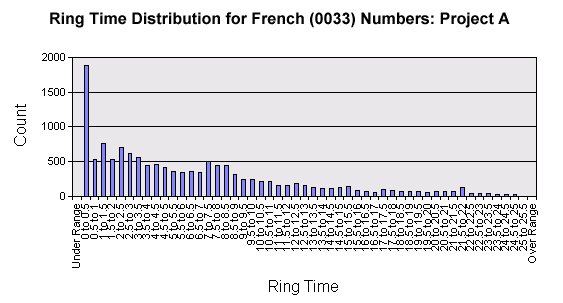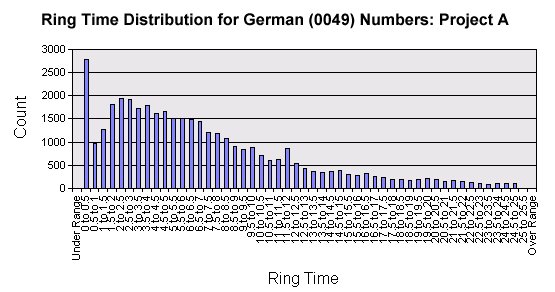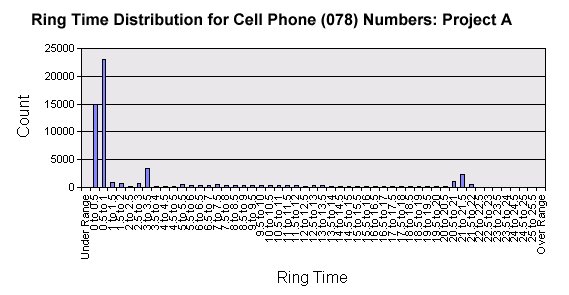Ring time
Ring time is the time from when the respondent's phone starts ringing until it is answered. The table shows the number of calls that were answered and the ring time of those calls in seconds.
|
Property
|
Base
|
Project A
|
Project B
|
|
Base
|
269724
|
200962
|
68762
|
|
Minimum: RingTime
|
–
|
–
|
–
|
|
Maximum: RingTime
|
32
|
22
|
32
|
|
Mean: RingTime
|
10.9
|
10.3
|
12.8
|
|
Standard Deviation: RingTime
|
5.82
|
5.18
|
7.17
|
|
Lower quartile
|
6.5
|
6.3
|
7.2
|
|
Median
|
10.2
|
9.9
|
11.9
|
|
Upper quartile
|
15.4
|
14.3
|
19.3
|
These results were distributed as follows:
Ring time analysis: Project A
Ring time analysis: Project B
The no answer time-out can be observed in the maximum ring time values of 22 to 32 seconds. The Project A results generally follow a normal distribution with the exception of a lot of calls that were answered around 16 to 17 seconds. It is suspected these are due to calls answered by the British Telecomm (BT) voice mail service. Project B is interesting in the number of calls that are answered immediately, again probably due to calls being redirected to voice mail for some reason.
The ring time distribution of the Project A calls was analyzed per hour over all calls. The distribution is fairly consistent throughout the day. The only noticeable difference is that more calls are answered during the 16 to 17 second peak (assumed to be BT's voice mail feature) between 3pm and 4pm, presumably because some respondents were at work during this time.
Ring time distribution 3pm to 4pm: Project A
Ring time distribution 8pm to 9pm: Project A
Calls to different numbers and geographical regions show a little variation when analyzed for Project A. The ring time distribution is fairly consistent across all regions in the UK and is basically represented by the overall project ring time distribution shown at this start of this section. This is because the call logs are dominated by calls to UK land line numbers. There is some variation for calls to international numbers and cell phones.
Ring time distribution: Calls to France (0033)
The following two charts show the ring time distributions for France (0033) and Germany (0049). Both charts show a lot of calls are answered within one second (presumably by voice mail) and generally a shorter ring time than the UK calls. These charts also lack the peak at 16 to 17 seconds which reinforces the assumption that it is due to a BT voice mail feature.
Ring time distribution: Calls to Germany (0049)
Calls to UK cell phones (077, 078, and 079 numbers) showed most calls were answered within one second which is slightly unbelievable and possibly due to how cell phone networks report call alerting information back to the dialer (this could also be a possible explanation for the one second peak in the charts for France and Germany). The following chart shows the ring time distribution for calls to cell phones with 078 numbers.
Ring time distribution: Calls to cell phones (078)
The conclusion based on these analyses is that the ring time is slightly dependent on the particular number being dialed, but not so much on when the number is being dialed. Some calls seem to be answered, probably automatically, within one second, otherwise the ring time distribution varies slightly between different sets of sample.
See also
